Archive for Irrigation
How Irrigation Can Improve Your Lawn, Garden and Curb Appeal
The reasons that homeowners and businesses have irrigation systems installed are easy to understand. They’re trying to eke out more bang for their buck by going with irrigation advancements like micro irrigation, drip irrigation and spray tanks.
Irrigation is simply the best way to ensure that your home garden and lawn care needs are being met without having to worry about underwatering or overwatering.
Because irrigation and home sprinkler systems can be automated, you don’t need to fuss about achieving the best results possible.
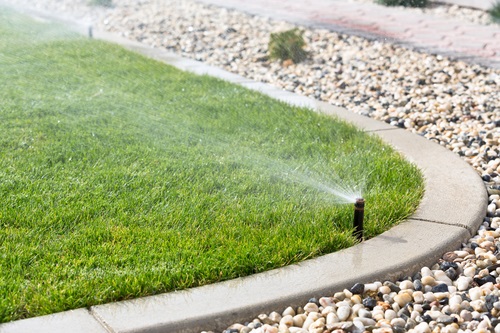
Irrigation Benefits Your Entire Property
You can even automate your system to behave differently in your garden versus your lawn, and you can also change up your watering cycles based on seasonal changes or plant growth.
Drip irrigation systems can also be extended to reach places that are just growing in or ones that didn’t exist when you originally installed the system. In terms of modifiability and adaptability to changing conditions, that’s pretty much the gold standard.
Especially when you’re dealing with a larger lawn in an arid region or a larger commercial property that needs virtually around-the-clock attention, an automated sprinkler system coupled perhaps with a drip irrigation setup can actually save you money long term. Homes benefit and conserving water, money and manpower is what it’s all about.
- Save Water, Conserve Manpower, Increase Curb Appeal
Drip irrigation is especially advantageous to homeowners and businesses in arid regions of the country that seasonally experience droughts, water shortages and steeper water prices (e.g., states like California).
The way that drip irrigation works – allowing water to drip down to different plants and root zones via pipes, emitters and valves – can consistently deliver more water to the roots and increase yields….all while saving water.
At the same time that you’re saving 50% more water compared to regular sprinkler systems, you’re getting better coverage and you’ll naturally experience less weed growth.
All of this together could very well bolster your curb appeal or, if you’re running a business, bring in more customers: A professional first impression goes a long way.
Incorporating Irrigation Into Your Lawn Care Routine
Business owners reading this might be scratching their chins and wondering whether they really need an irrigation system or if they can get by with simply watering twice a week. First off, you should realize that simply watering might not be enough.
If you’re running a commercial property, then irrigation is but one piece of the puzzle when it comes to maintaining a professional image. Mowing, mulching, fertilization, aeration and leaf removal might all be part of the overall picture in terms of getting the most out of your property or maximizing the curb appeal of your home.
That said, irrigation is one of those foundational lawn care services that really gets at the heart of landscaping. Why? Because irrigation delivers water right to the root source and if plants, trees and lawns don’t have enough water and sunlight they’ll definitely under-perform.
- Easy (and Expandable) Installation
While soaker hoses and sprinkler hoses might be the easiest-to-install and most DIY form of drip irrigation around, even professionally installed drip irrigation systems are relatively simple to install and shouldn’t require any excavation at all.
Because residential and commercial irrigation systems frequently rely on tubing, you can work with a landscape maintenance company to home in on the best location for the system. You can even move the system around if your needs change or power up/down the system to fit seasonal changes.
Drip irrigation systems efficiently deliver water right to the root source and are ideal for cost-efficiently achieving the best lawn possible. Consult with us on how you can benefit.
The Necessity of Irrigation
You want an awesome lawn. When you invest in landscaping service, you expect your lawn’s greenery — your greenscape — to remain beautiful and awesome for a very long time. Despite the fleeting nature of plants, maintaining a beautiful greenscape throughout the year is very possible. To this end, one of the most important things for you to do is to have an irrigation system installed. Although these systems are often only thought of as something for growing crops, irrigation is actually a necessity for your lawn. This isn’t just a matter of watering your plants either. Let’s take a look at why irrigating your lawn is so important for it’s health.
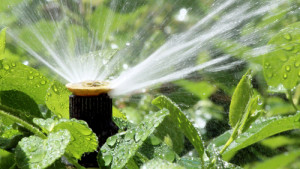
Irrigation Makes Your Greenscape More Durable
Rainwater and hand-poured water only moisturize plants at the surface level. Their roots, however, go very deep into the ground. This means that under normal circumstances, the bottom of your roots are extremely dry. That’s like only dipping your legs into the pool on a 100 degree day, while leaving your torso to be burned by the scorching sun! Such dryness makes it a whole lot harder for your plants to resist tougher conditions, because in addition to having dry roots, they won’t be able to gather up enough water for their plant bodies.
Irrigation solves this problem by collecting water and sending it straight down to your plants’ roots, resulting in a wet, sturdy greenscape.
Irrigation Makes Sure That Your Greenscape Evenly Grows
A bright, healthy lawn can still look patchy. This happens when your lawn gets different amounts of water in each area. When this happens, some plants are bound to grow way faster than others, resulting in an ugly, patchy appearance for your lawn. This sucks!
Irrigating your lawn lets you evenly distribute the water that gets into your lawn. This way, the patches of grass near the patio will look exactly the same as the strips of grass lining the patio.
Irrigation Protects Your Greenscape From Droughts
California isn’t the only place that has had water problems in the past. You don’t have to be in a desert to end up in a drought. In fact, low rainfall can happen just about anywhere — unless you live inside of a rain cloud! When a drought happens, your lawn’s greenscape will be among the first things to be harmed. This is because plants rely on water even more than we do to live long, healthy lives.
A good irrigation system can fully protect your lawn’s plants from a drought by spraying water on the plants regularly, even if it doesn’t rain all season.
Irrigation Reduces Your Workload
Even if you have two green thumbs and green big toes, maintaining a lawn isn’t easy. One of the hardest parts of this process is making sure that your plants get all of their proper nutrition. An irrigation system handles the lion’s share of the workload needed to keep your plants healthy, because they will provide them with all of the water that they need on a daily basis. In fact, if your lawn has plants that crave more water than usual, your irrigation system can send plenty of water to your plants multiple times per day.
Irrigating Your Greenscape Takes The Worry Out of Lawn Care
Having an awesome lawn is your goal. Achieving that goal shouldn’t be such a hard thing to do. By investing in a lawn irrigation system, you will make sure that your lawn is absolutely awesome at all times. Contact us to learn more about the benefits of lawn irrigation, and what types of systems are available.
What is Drip Irrigation and Its Advantages?
 You may have heard the phrase “drip irrigation” thrown around and not been able to make heads or tails out of it. Fortunately, drip irrigation isn’t that complicated a concept to really understand.
You may have heard the phrase “drip irrigation” thrown around and not been able to make heads or tails out of it. Fortunately, drip irrigation isn’t that complicated a concept to really understand.
What is Drip Irrigation?
Irrigation is simply the process of artificially applying water to land or soil in order to stimulate growth. Farmers and property owners around the country rely on irrigation to create fuller crops or more appealing lawns.
Drip irrigation, also referred to as trickle irrigation, is a method of irrigation that’s extremely environmentally friendly. This is because drip irrigation applies water directly to the plant’s roots, root zone or the soil itself.
The fact that drip irrigation sends water directly to the surface that needs it most with a plastic device known as an emitter is especially relevant today. Parts of California, Texas and the Southwestern United States are experiencing their worst droughts in years, so a more intelligent irrigation system is a must.
Drip irrigation actually uses tubes and hoses to efficiently send water to a plastic emitter, which in turn sends water directly onto the plant’s roots or soil’s surface. This whole process saves a ton of water and fertilizing material.
More Advantages of Drip Irrigation
Even for farmers or property owners who like using fertilizer, drip irrigation allows you to retain nutrients while using less fertilizer – all the while achieving even better results!
Drip irrigation also allows you to keep the moisture level constant between the root zone and field capacity. And just to clarify, the term “field capacity” is simply the amount of moisture in the soil after the excess water has drained away.
Here’s some more good news for anyone who wants to try out drip irrigation – drip irrigation ensures less soil erosion and fewer weeds grow on your property. For farmers, this is a huge boon and directly increases their crop yield and profits. For regular property owners, this leaves your lawn looking crisp, green and lush.
For those concerned about rising energy prices, you’re bound to like drip irrigation as well. The process of drip irrigation is extremely water efficient and operates under less pressurization than most other types of pressurized irrigation, which translates to money saved on utility bills.
Because of drip irrigation’s higher efficiency, you’re also talking about smaller labor costs compared to other forms of irrigation.
Control in Your Hands
Due to the fact that controllable amounts of water make their way to the soil’s surface or the roots of plants, drip irrigation puts far more control into your hands.
You can regulate the amount of water that gets sent to each individual plant or section of your property by regulating the water pressure going to each output nozzle.
Drip irrigation is saving you water all the while as well since drip irrigation is estimated to use less than half the water of conventional sprinkler systems. So, you’re using less water and experiencing less nutrient runoff and soil erosion: This is definitely a recipe for long-term success.
Drip irrigation can even be set to a timer so that you can fully automate the watering process or cut it on/off at your discretion throughout the day. A drip irrigation system is highly adaptable and can be changed literally overnight to better suit the changes taking place on your property.
You can find out more about drip irrigation or set up an appointment by getting in touch with a Xeriscape lawn care professional today.
Sprinkler System Design That Saves You Money
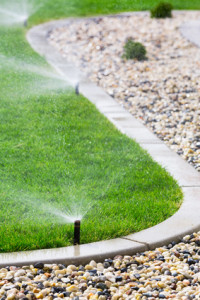 When it comes to keeping your landscaping looking lush and healthy, your sprinkler system design could make all the difference. If your plants are getting too much water you may encounter problems such as mold, rotting, and even yellowing of your plants. Likewise, if your plants are not getting enough water, they can quickly turn yellow and brown, dying back and leaving you with large dead patches in your garden.
When it comes to keeping your landscaping looking lush and healthy, your sprinkler system design could make all the difference. If your plants are getting too much water you may encounter problems such as mold, rotting, and even yellowing of your plants. Likewise, if your plants are not getting enough water, they can quickly turn yellow and brown, dying back and leaving you with large dead patches in your garden.
Sprinkler system design needs to meet all of your plants different water needs. This can be tricky, especially if you have different types of annuals, perennials, shrubs, and trees, grouped together throughout your garden. A small shrub may need water once a week, whilst the small annual flowers you have growing around the shrub may need to be watered daily, finding that balance can be hard.
Why Hire a Gardener or Landscape Team for Your Sprinkler System Design
There are many complexities when it comes to the best sprinkler system design for your garden, hiring an experienced gardener will ensure that your garden is having its exact watering needs met. Here are some of the things a good gardener will look for when it comes to sprinkler systems.
- When it comes to sprinklers there are many different types, choosing the right sprinkler head can make sure that your garden is getting the right amount of water, protecting your plants from too much or too little water. An experienced gardener or landscape expert will know which sprinkler head to use, in which areas of your garden.
- Water pressure needs to be considered when it comes to a sprinkler system, your water pressure should be evaluated and upgrades to the system should be made to account for either a lack of pressure, or too much pressure.
- Pipes will need to be placed throughout your lawn and garden. By having a professional design the pipe layout and lay the pipes, you can be sure that your current garden and lawn will be protected. You will also have peace of mind knowing that your systems pipe design will help you reduce your water usage, whilst providing your garden with the water it needs.
- When it comes to your sprinkler system design the placement of each sprinkler head is important. As previously mentioned there will be areas in your garden that need less water, while other plants or areas may need a lot of water on a daily basis. By accounting for run off, sprinkler direction, and which plants need more or less watering, an experienced gardener can place your sprinkler heads in the right position to benefit all plants in your garden.
- If you would like your sprinkler system design to be as low maintenance as possible, you may want a system that is automated. Hiring a gardener to design, install, and set up your system will make sure that your sprinkler system is running at a time that gives your garden the best chance of soaking up the water. This will make sure that you are not losing valuable water to the heat of the day, or causing disease to spread through your garden.
Contact Us Today for Your Sprinkler System Design
If you have been considering sprinkler system design for your home or business, contact our landscape maintenance company today. Our team of garden and landscape experts can help you get the best sprinkler system design, keeping your garden and landscape healthy no matter the season.
The Art of Irrigation
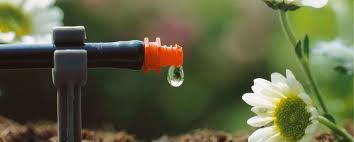
One of the challenges for a gardener is managing the proper use of water. The lack of water can be damaging, or deadly, to anything growing outside. DK Landscaping shares the art of irrigation and will help you prepare your garden for it.
Benefits of Drip Irrigation
By using drip irrigation, your garden will use less water, will require less maintenance, and help discourage less weeds and pests. You will be giving them the moisture they need, where they need it: at their root zone.
It will save you up to 90% compared to watering with a hose. It saves you time having your drip system on a timer. You control your irrigation timer and adjust it for seasonal changes (for instance, August heat in Northern California consumes the most water). Together with mulch creates an organic weed control without the use of harsh and unhealthy chemicals. Watering only the roots of your plants with drip irrigation also cuts down on water-borne pests and fungal diseases that spread by water movement.
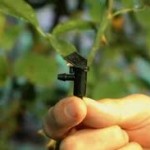
With a timer, you can control how much water your plants receive by setting up your drip system with different size emitters, which are the system’s delivery mechanism. You can use a small emitter, such as one that delivers 1/2 gallon of water per hour, at the base of small plants, such as herbs; for larger plants, such as trees, you can provide more than one emitter that delivers 3 gallons of water per hour, or more.
DK Landscaping also recommends that all valves feeding the drip system should have:
Large Filter: A small filter or no filter will result in debris clogging the system.
Pressure Reducer: Absence of it will result in emitters being blown off the main feed line. Drip systems are designed to work under low pressure (nominally between 25 PSI to 35 PSI) while normal pressure on the water main line is nominally 70 PSI.
Pressure Compensated Emitters: Pressure compensating drip emitters (PC Emitters) deliver a consistent output of water, even with increase changes in elevation or pressure due to long drip runs. PC Emitters are best used in landscapes and gardens that have drops in elevation that would cause an increase in pressure.
Emitter Hole Punch: Oval or wrongs size holes will result in leaks.
For more information and a free consultation on your irrigation system, please contact Kathy Lee at DK Landscaping. Kathy is our QWEL (Qualified Water Efficient Landscaper) Certified Irrigation Expert. We are also a certified WaterSense Partner. QWEL and WaterSense are certified by the EPA.
Irrigation Sensation
Summer is just around the corner which means, for most of us…the “dog days” are coming!
DK Landscaping brings you tips on how to beautify your landscape while maintaining the lusciousness of your lawn through irrigation.
A great lawn is a start to an exceptional landscape. Landscaping will not only make your property look better, but will also raise your property values. Adding effects and color can increase the value of your home and property by as much as 10% depending on your lawn, landscape and property.
Watering your lawn is essential to protect your landscaping investment. A residential sprinkler system improves the overall health of all plantings because of the consistent water being delivered. It not only helps manage your water usage — but you will have a greater appreciation for when your water bill arrives each month.
DK Landscaping recommends the best time to water your lawn is in the morning, before the heat of the day has set in, so moisture has time to evaporate before the evening. Watering in the evening can result in rot and fungal infections of the plant roots being left moist and cold at night. We also believe it is far better to water a lawn deeply once a week than to give it shorter periods of water more frequently.
For more information and a consultation on your irrigation system, please contact David Lee at DK Landscaping.






